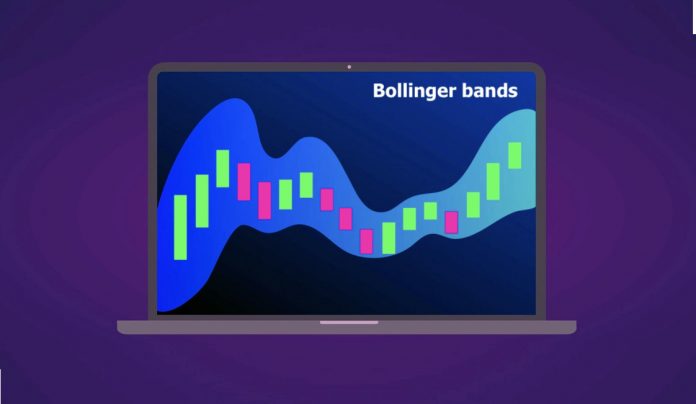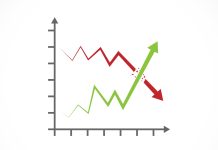![]() English
English ![]() हिन्दी
हिन्दी ![]() Indonesia
Indonesia ![]() Português
Português ![]() Tiếng Việt
Tiếng Việt ![]() العربية
العربية ![]() ไทย
ไทย
Olymp Trade analysts have developed a new, branded indicator called the Inversion Bollinger. It looks like an oscillator and is displayed below in the chart.
It is based on the widely known Bollinger Bands indicator. Inversion Bollinger shows when the market is overbought or oversold according to probability theory, and therefore works well with other oscillators to precisely identify reversal points.

To understand how the Inversion Bollinger works, let’s recall the basic principles of the Bollinger Bands indicator.
Register Olymp Trade & Get Free $10,000 Get $10,000 free for newbies
The indicator consists of three lines:
- Middle line – the SMA with a default period of 20.
- Topline – the central line shifted up according to standard deviations (2 by default).
- Bottom line – the central line shifted down according to standard deviations (2 by default).
The value of the standard deviation depends on the distance between the price and the 20 SMA. In other words, it depends on volatility. The bands become wider when the market is actively rising or falling and become more narrow when the market moves sideways.
The main principle of using Bollinger Bands is that when using the two standard deviations, only 5% of the prices will reach above the upper and below the lower bands of the indicator. 95% of prices will be maintained inside the bands. If the standard deviation parameter is increased to three, then 99% of prices will be inside the indicator, and only 1% will reach outside in terms of probability theory.
Structure of Inversion Bollinger
Looking at the structure of the Inversion Bollinger indicator, let’s add another Bollinger Bands indicator with a standard deviation of 3 and turn on the intermediate levels +/- 2 sigma in the Inversion Bollinger settings.

Inversion Bollinger represents 2 “straightened” Bollinger Bands. The oscillator shows the current price value relative to the 20 SMA, as well as the upper and lower Bollinger Bands with two and three standard deviations in the following situations:
- When the price touches the 20 SMA, the Inversion Bollinger is located at the 0 marks.
- When the price crosses the upper band of the Bollinger Bands with two or three standard deviations, the Inversion Bollinger will cross the +2 or +3 sigma lines, respectively.
- Likewise, when the price crosses the lower Bollinger Bands with two or three standard deviations, the Inversion Bollinger will cross the -2 or -3 sigma line.
Signals from the Indicator
Since the Bollinger Bands indicator helps to identify certain properties of a trend, the Inversion Bollinger has similar characteristics. The direction of the indicator can help us identify the structure of the trend in the following cases:
- If the indicator line is above 0, it means that the market is in an uptrend. If the Inversion Bollinger is below zero, a downtrend.
- If the trend is steady and calm, the Inversion Bollinger will move gradually from 0 to the two sigmas or from the -2 sigma to 0.
- If the Inversion Bollinger begins to fluctuate near the +/- 2 sigma levels, it means that the market is in an active, steady trend. On the Bollinger Bands, this situation is called a “Bollinger Band Walk.” It often occurs on assets with JPY. Trading against this kind of trend is not recommended.
Remember that the indicator, like its counterpart, becomes more sensitive during a sideways or flat market and less sensitive during active trends.
The area above two sigma is considered the overbought zone, the area below -2 sigma is the oversold zone. A return from these areas will give one type of signal for opening trades. However, the strongest signal from the Inversion Bollinger will be obtained when the indicator line touches or breaks beyond the +/- 3 sigma levels.
Signals to Open an UP Trade:
- The indicator line crosses the -2 sigma from the bottom up.
- The indicator line touches or breaks below -3 sigma.

Signals to Open a DOWN Trade:
- The indicator line crosses the two sigmas from top to bottom.
- The indicator line touches or breaks above three sigmas.

Combining with Other Indicators
The Inversion Bollinger’s primary purpose is to evaluate potential market reversal points, which is why one of the most useful supporting tools that a trader can use in this case are support and resistance levels.
Register Olymp Trade & Get Free $10,000 Get $10,000 free for newbies
You may notice that trend reversals usually occur near strong levels of support or resistance. It is recommended to add levels of support and resistance to the price chart in the time frame in which you are working. You can also use the Pivot Point indicator and Fibonacci levels, which help to identify support and resistance levels.
Combining levels works especially well with signals from Inversion Bollinger extremes. When the price touches a strong level of support or resistance and the Inversion Bollinger indicator simultaneously touches or breaks beyond the +/- 3 sigma, the received signal will be more reliable.
The indicator also works well with other oscillators such as the RSI. Oscillators help to determine when the market is overbought or oversold but use a different mathematical approach.
As a result, their combination helps to determine reversal points with great accuracy.
If the RSI (or any similar oscillator) is overbought or oversold at the time of the Inversion Bollinger signal, that signal will be more reliable.

Notice the situation on the left. The RSI reached and even crossed the 30% level indicating that the asset is oversold. While in the situation on the right, the Inversion Bollinger reached the three sigmas line, but the RSI didn’t yet signal a potential reversal, and the signal became weaker.
Conclusion
The Inversion Bollinger is the Bollinger Bands indicator turned into an oscillator, which is why it has both advantages and disadvantages over its predecessor. Like any other indicator, it is not perfect, and it is recommended to use different indicators especially other oscillators.
Even when you form a working trading strategy based on several indicators, it is important to remember other successful trading elements such as trading psychology and money management. It is the combination of these three essential trading components that will bring you stable financial results.
![]() English
English ![]() हिन्दी
हिन्दी ![]() Indonesia
Indonesia ![]() Português
Português ![]() Tiếng Việt
Tiếng Việt ![]() العربية
العربية ![]() ไทย
ไทย









 General Risk Notification: Transactions offered by Olymp Trade can be executed only by fully competent adults. Transactions with financial instruments offered on Olymp Trade involve substantial risk and trading may be very risky. If you make Transactions with the financial instruments offered on Olymp Trade, you might incur substantial losses or even lose everything in your Account. Before you decide to start Transactions with the financial instruments offered on Olymp Trade, you must review the Service Agreement and Risk Disclosure Information. Olymp Trade is operated by Saledo Global LLC; Registration number: 227 LLC 2019; Registered Office Address: First Floor, First St. Vincent Bank Ltd Building, P. O Box 1574, James Street, Kingstown, St. Vincent & the Grenadines.
General Risk Notification: Transactions offered by Olymp Trade can be executed only by fully competent adults. Transactions with financial instruments offered on Olymp Trade involve substantial risk and trading may be very risky. If you make Transactions with the financial instruments offered on Olymp Trade, you might incur substantial losses or even lose everything in your Account. Before you decide to start Transactions with the financial instruments offered on Olymp Trade, you must review the Service Agreement and Risk Disclosure Information. Olymp Trade is operated by Saledo Global LLC; Registration number: 227 LLC 2019; Registered Office Address: First Floor, First St. Vincent Bank Ltd Building, P. O Box 1574, James Street, Kingstown, St. Vincent & the Grenadines.